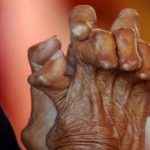 A chronic bacterial disease of the skin and nerves in the hands and feet and, in some cases, the lining of the nose. It is caused by the Mycobacterium leprae. Also called Hansen’s disease.
A chronic bacterial disease of the skin and nerves in the hands and feet and, in some cases, the lining of the nose. It is caused by the Mycobacterium leprae. Also called Hansen’s disease.
A chronic mycobacterial disease caused Mycobacterium leprae, characterised by skin lesions and necrosis.
A chronic disease of the skin and nerves characterized by whitish pigmentation.
A chronic, contagious disease caused by a bacterial infection characterized by large nodules on the surface of the body, loss of sensation, paralysis, wasting of muscles, and body deformities.
An infectious bacterial disease of skin and peripheral nerves caused by Mycobacterium leprae, which destroys the tissues and causes severe disfigurement if left untreated.
Chronic, communicable disease, caused by Mycobacterium leprae, that is widespread throughout the world, chiefly in tropical and subtropical regions. In tuberculoid leprosy, tumor-like changes occur m the skin and cutaneous nerves; in the more serious and progressive lepromatous leprosy, lesions spread over much of the body with widespread nerve involvement affecting many systems of the body. Treatment usually involves the use of sulfones (especially dapsone); a vaccine with promising results is also being used.
A chronic infectious disease caused by the bacterium called Mycobacterium leprae, which affects the peripheral nerves, skin, and mucous membranes. Leprosy is also known as Hansen disease and affects about lo million people worldwide, most commonly in Asia and Africa, but also in Mexico, South and Central America, and the Pacific islands. There are a relatively small number of cases in the United States, almost all of them involving immigrants from developing countries who have settled in Texas, California, or Hawaii. Severe cases are more common in men than in women, and the peak ages of onset are in a person’s 20s or 30s.
A chronic disease, caused by the bacterium Mycobacterium leprae, that affects the skin, mucous membranes, and nerves. It is confined mainly to the tropics and is transmitted by direct contact. After an incubation period of 1-30 years, symptoms develop gradually and mainly involve the skin and nerves. Lepromatous leprosy is a contagious steadily progressive form of the disease characterized by the development of widely distributed lumps on the skin, thickening of the skin and nerves, and in serious cases by severe numbness of the skin, muscle weakness, and paralysis leading to disfigurement and deformity. Tuberculosis is a common complication. Tuberculoid leprosy is a benign, often self-limiting, form of leprosy causing discoloration and disfiguration of patches of skin (sparsely distributed) associated with localized numbness. Indeterminate leprosy is a form of the disease in which skin manifestations represent a combination of the two main types. Leprosy can be controlled, but not cured, by prolonged treatment with sulfone drugs.
Also known as Hansen’s disease, this is a chronic bacterial infection caused by Mycobacterium leprae and affecting the skin, mucous membranes, and nerves. Infection is now almost confined to tropical and subtropical countries mostly in Africa and India. There are two distinct clinical forms: tuberculoid and lepromatous. The former usually takes a benign course and frequently burns out, whereas the latter is relentlessly progressive; between these two polar forms lies an intermediate/dimorphous group. Nasal secretions (especially in lepromatous disease) are teeming with M. leprae and constitute the main source of infection; however, living in close proximity to an infected individual seems necessary for someone to contract the disease. M. leprae can also be transmitted in breast milk from an infected mother.
A chronic infectious disease of the skin and peripheral nerves, caused by Mycobacterium leprae. In chronically infected persons, it may produce characteristic ring-shaped, nodular, or erosive skin changes, especially on or near the face, and sensory and motor dysfunction, especially of the hands and feet. Approx. 700,000people are infected each year worldwide; leprosy is endemic in India (the site of 70% of cases) and other tropical countries. It occasionally is reported in the U.S., e.g., in Hawaii, where it was once endemic, and in the Gulf Coast states, where it is carried by an animal host, the nine-banded armadillo.
A chronic contagious disease occurring almost exclusively in tropical and subtropical countries; characterized by lesions of the skin or nerves with resulting deformities and mutilations. It is caused by the bacterium, Mycobacterium leprae. It is of low infectivity arid the mode of spread is unknown, but intimate contact with a leper is essential. Only 3 percent of people living with lepers contract the disease, children being more susceptible than adults. The prognosis in advanced cases is not good, but if treated early, the life expectancy is increased and some cases are completely cured. Patients are not discharged until they have been germ-free for at least two years, and even then it is not possible to say whether they are cured or only having a remission for which leprosy is notorious. Also called Hansen ‘s disease.
